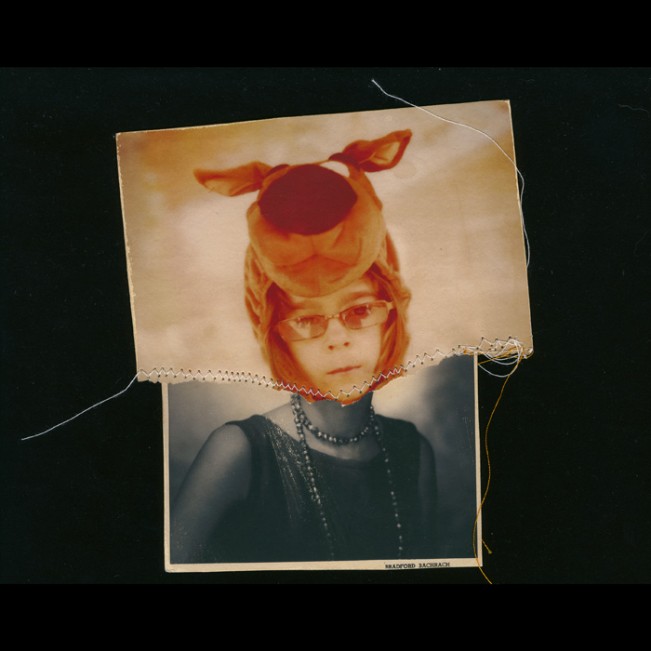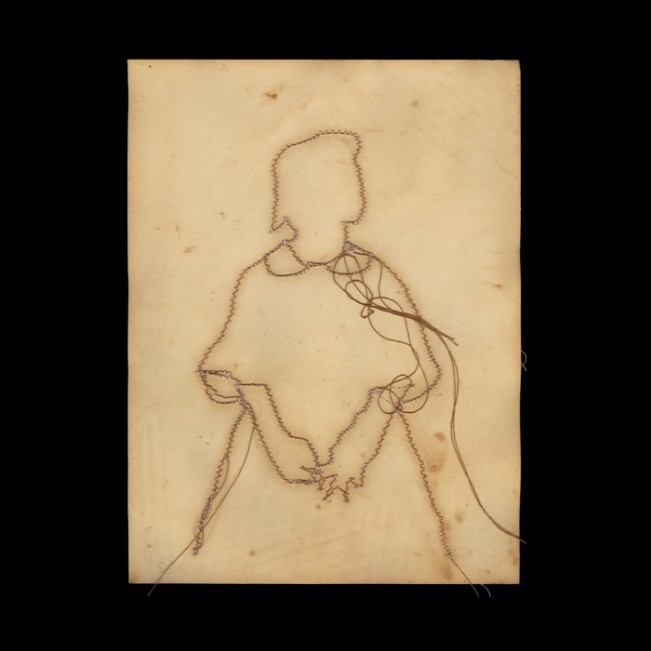Liz Steketee: Sewn/Traces

Liz Steketee has been coloring outside the lines for sometime time now. She has created a myriad of interesting projects untilizing family and found photos, so many that I had a hard time selecting one to showcase today. Liz has also been on the forefront of artist bookmaking, and in fact, she was celebrated with her very own booth at Photo L.A. a few years back. Today I feature her project, Sewn/Traces.
Liz lives in the San Francisco Bay Area with her husband and two children where she maintains her own art practice. Additionally, Liz is a member of the photo faculty at the San Francisco Art Institute where she specializes in digital imaging and compositing, digital printing, and the handmade book. In 2011, Nazraeli Press published Liz’s work in a One Picture Book, Dystopia. In 2002, Liz published a hardcover photography book examining fly fishing guides of the American West, Castwork. In 2005, Liz completed her MFA at the San Francisco Art Institute. At SFAI, Liz received the prestigious John Collier Award of Excellence for her Masters thesis project. This project was based on the turbulent circumstances surrounding the birth of Liz’s first child, Emma. After completing her graduate studies, Liz dedicated her work fully to art practice and teaching. Liz’s personal work focuses the subject of family dynamics and domestic life. Sub texts in her work explore the notions of photography and its role in family life, memory, and our sense of self.
Sewn/Traces
Sewn is a mixed media body of work that combines photographs from my extensive archive with collage and sewing techniques. Sewing disparate elements together establishes tension that asks the viewer to questions traditions.
In Sewn, I use digital photomontage, physical collage, and sewing processes to create unique object-based artworks. This body of work does not adhere to the purity of one process or material over another. My subject matter explores the notions of photography’s impact on memory and history, human interactions as we navigate “family”, and examining the traditions of vernacular and portrait photography. I alter, chop, merge, and recompose photographic elements. Sometimes I cut, obliterate, or erase elements of an image to draw attention to what is missing, what may have changed, or what needs to be considered. The most recent manifestation of this work examines the traces left behind in the process of creating the work, specifically the backs of the images viewed as the primary works in and of themselves. The altered photographic memory on the front inevitably leaves traces of memory behind. These processes are intended to jar the viewer and call into question our history through memory and as photographic document. It is my belief that photographs play an integral part in our understanding of identity and memory. As such, our family images influence who we believe we are. What happens when these images we learn from are altered? I question traditional portraiture and what it reveals to us. I break the rules of traditional photography by mixing elements and materials that do not necessarily belong together. I allow subjects to express emotions or information long repressed, causing a shift in expectations. Finally, I explore the traditions of sewing and photography colliding and establishing new ground. This work carries subtexts for me such as, the notion of truth in photography, the connection between photographs and memories, and the visual history and impact of the tradition of portraiture.
I alter, chop, merge, and recompose photographic elements. Sometimes I cut, obliterate, or erase elements of an image to draw attention to what is missing, what may have changed, or what needs to be considered. The most recent manifestation of this work examines the traces left behind in the process of creating the work, specifically the backs of the images viewed as the primary works in and of themselves. The altered photographic memory on the front inevitably leaves traces of memory behind. These processes are intended to jar the viewer and call into question our history through memory and as photographic document. It is my belief that photographs play an integral part in our understanding of identity and memory. As such, our family images influence who we believe we are. What happens when these images we learn from are altered? I question traditional portraiture and what it reveals to us. I break the rules of traditional photography by mixing elements and materials that do not necessarily belong together. I allow subjects to express emotions or information long repressed, causing a shift in expectations. Finally, I explore the traditions of sewing and photography colliding and establishing new ground. This work carries subtexts for me such as, the notion of truth in photography, the connection between photographs and memories, and the visual history and impact of the tradition of portraiture.
The combination of these elements provokes questions and comparisons that have much to teach us. By juxtaposing these elements, I am interested in seeing what “happens” as these views come together. I use my life as material for my work. By doing this, I am able to explore the conflicts that exist within the everyday and the richness that is found in the mundane. I feel strongly that life and art belong together, intertwined in everyday experiences. I began doing this in earnest when I got married and started a family. The shift in responsibility that accompanied becoming a parent, led to my use of real life as subject matter for my art. I felt greatly challenged by the prospect of guiding another human’s life and to best understand it, I turned the camera on it. From these documentary images, I create composites or “paintings” that define my vision of experience. Through the use of montage, collage, and purposeful juxtaposition of images, it is my intention to present the “truth” of life. I alter, chop, merge, and recompose photographic elements. This process allows me to represent a moment, a memory, or life’s reality as I see it. I disrupt linear structures and confuse elements of time and space to convey my notion of how life truly exists; a combination of independent moments that converge to leave us with a unique experience. This process is intended to jar the viewer and call into question our history through memory and as photographic document.– Liz Steketee, 2013
I use my life as material for my work. By doing this, I am able to explore the conflicts that exist within the everyday and the richness that is found in the mundane. I feel strongly that life and art belong together, intertwined in everyday experiences. I began doing this in earnest when I got married and started a family. The shift in responsibility that accompanied becoming a parent, led to my use of real life as subject matter for my art. I felt greatly challenged by the prospect of guiding another human’s life and to best understand it, I turned the camera on it. From these documentary images, I create composites or “paintings” that define my vision of experience. Through the use of montage, collage, and purposeful juxtaposition of images, it is my intention to present the “truth” of life. I alter, chop, merge, and recompose photographic elements. This process allows me to represent a moment, a memory, or life’s reality as I see it. I disrupt linear structures and confuse elements of time and space to convey my notion of how life truly exists; a combination of independent moments that converge to leave us with a unique experience. This process is intended to jar the viewer and call into question our history through memory and as photographic document.– Liz Steketee, 2013

Posts on Lenscratch may not be reproduced without the permission of the Lenscratch staff and the photographer.
Recommended
-
Carolina Krieger: The intertwining of the abyssDecember 28th, 2024
-
Sylvia Sanchez: Out of the OrdinaryDecember 27th, 2024
-
Interview with Dylan Hausthor: What the Rain Might BringDecember 23rd, 2024
-
Julie Anand & Damon Sauer: Art + Science Competition Second Place WinnersDecember 17th, 2024
-
Photography Educator: Eliot DudikDecember 13th, 2024









































































